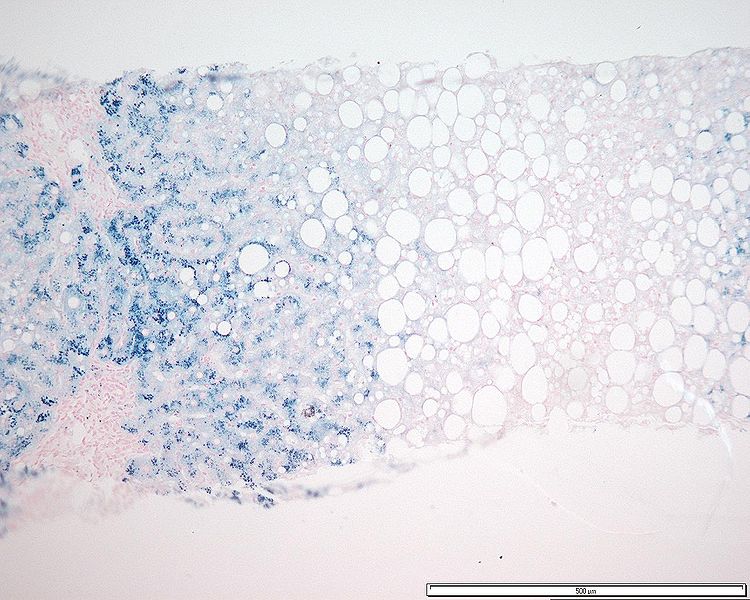Playlist
Show Playlist
Hide Playlist
Wilson's Disease with Case
-
Slides Gastroenterology 12 Liver Pt2 NAFLD.pdf
-
Reference List Gastroenterology.pdf
-
Download Lecture Overview
00:02 Let's move on to our next case. 00:04 A 19-year-old woman is admitted for new confusion and jaundice for one week. 00:09 She has no history of liver disease, does not drink alcohol and does not use illicit drugs. 00:15 She takes no medications or supplements. 00:18 She has not traveled recently. 00:20 Her vitals are notable for a blood pressure of 85/52 (mmHg) and heart rate of 115 (bpm). 00:26 She is disoriented. 00:29 Physical exam is notable for jaundice and asterixis. 00:32 On slit-lamp exam, she has golden brown discoloration around her irises. 00:38 Labs show an AST of 250 (U/L), ALT 225 (U/L), INR 1.7 and total bilirubin of 6.5 (mg/dL). 00:48 Her viral hepatitis serologies are negative. 00:51 So what is the most likely diagnosis? Here we can point out that she has confusion and jaundice which localizes to the hepatobiliary system. 01:03 And importantly, she has a negative history of any exposures known to cause liver injury. 01:08 So no known liver disease, no alcohol, illicit drugs, medications and no recent travel. 01:16 On physical exam, she appears ill and is disoriented which is quite concerning. 01:24 And she has this golden brown discoloration around the irises of her eyes, these are what we might call Kayser-Fleischer rings. 01:33 In addition, she has lab findings of acute liver failure. 01:39 So, her most likely diagnosis is Wilson's disease. 01:43 This is a rare congenital disorder of copper metabolism. 01:49 Patients may present from with acute liver failure at a young age or it may be a more chronic insidious process leading to liver disease causing neurologic problems in older age. 02:02 The diagnosis is made by mild elevation in transaminases. 02:06 Patients often have a low alkaline phosphatase. 02:10 They often have a low cerulopasmin level, a high urine copper and you may do genetic testing if the diagnosis is still unclear. 02:21 Treatment is with copper chelating agents like trientine or penicillamine. 02:28 As a quick aside and a high-yield learning point, you should always remember to consider Wilson's disease on your differential if you see a young patient under age 40 with unexplained liver disease or acute liver failure. 02:44 So now let's go through some clinical features of this disease. 02:48 When copper deposits into the eye, this can lead to the typical appearance of Kayser-Fleischer rings which is these corneal deposition of copper around the irises. 03:00 This disease can also affect the brain leading to tremors, dystonias and dysarthrias, parkinsonism and changes in patient's behavior. 03:11 And of course, the liver can be effected. 03:14 So patients can develop an enlarged liver, inflammation or hepatitis. 03:18 They can have acute liver failure and they may have cirrhosis. 03:25 So now we return to our case. 03:27 Our 19-year-old woman with new confusion and jaundice. 03:31 She has no known exposures known to cause liver injury. 03:35 She does appear quite sick and she has this Kayser-Fleischer rings on exam. 03:40 So, first I'm gonna point out that Kayser-Fleischer rings on exam are not always present in real life. 03:47 But when you see them on a test, they are pathognomonic for Wilson's disease. 03:52 So you can make this diagnosis quite comfortably.
About the Lecture
The lecture Wilson's Disease with Case by Kelley Chuang, MD is from the course Disorders of the Hepatobiliary Tract.
Included Quiz Questions
Which of the following is one of the clinical manifestations of Wilson's disease?
- Corneal copper deposition
- Diabetes mellitus
- White nails
- Long, slender fingers
- Lumbar curvature
Which of the following is used for the treatment of Wilson's disease?
- Penicillamine
- Iron
- Copper
- Lactulose
- Rifaximin
Customer reviews
5,0 of 5 stars
| 5 Stars |
|
5 |
| 4 Stars |
|
0 |
| 3 Stars |
|
0 |
| 2 Stars |
|
0 |
| 1 Star |
|
0 |





